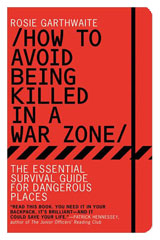How To Avoid Being Killed In A War Zone | By Rosie Garthwaite | Bloomsbury USA | 304 pages, $16.00
It is difficult to pick up a bright red manual titled How To Avoid Being Killed In A War Zone and not immediately flash to a scene of some poor correspondent, alone and in trouble, desperately looking for the right piece of information within its pages.
But upon reading Al Jazeera journalist Rosie Garthwaite’s invaluable guide, one hopes her audience will read it on the plane instead.
The author has assembled an impressive group of contributors from around the world and condensed their collective expertise into a well-organized, highly digestible resource. Just about every imaginable scenario is covered, from chest wounds to car bombs to kidnapping.
 But Garthwaite, who is donating thirty percent of her royalties from the book to Medecins San Frontieres (Doctors Without Borders), doesn’t forget the more subtle and delicate stuff. That may include declining tea or coffee in the Middle East and Asia so as not to wet oneself in the absence of a bathroom.
But Garthwaite, who is donating thirty percent of her royalties from the book to Medecins San Frontieres (Doctors Without Borders), doesn’t forget the more subtle and delicate stuff. That may include declining tea or coffee in the Middle East and Asia so as not to wet oneself in the absence of a bathroom.
Or how to calm yourself or a colleague in the event of a panic attack after one too many heart-stopping situations.
Or how to catch a fish with the items you have on hand.
It’s the kind of distilled wisdom that veteran war correspondents may have built up over decades, but that early-career reporters may not even know how to ask about.
A mix of the common-sense and the extraordinary, Garthwaite presents her material in just under 300 pages, keeping the tone conversational and lively. A Red Cross pamphlet this is not—which is a good thing, considering her target audience is probably not the type who likes to read the dictionary. It’s clear Garthwaite is addressing her kindred spirits with this manual, which is devoted in part to “Mum and Dad for their sleepless nights and support for my act-first-think-later adventures.”
As everybody knows, you have to be at least a little bit crazy to be a war correspondent. And as tragedies involving professional journalists in the Middle East, North Africa, Mexico, and elsewhere this year have demonstrated, even highly trained people find themselves overmatched sometimes. So the last thing the profession needs is unprepared adventurers going out into the field.
It’s heartening to see so many members of a sort of extended family of correspondents and operators, including Sebastian Junger, Chris Cobb-Smith, and Wadah Khanfar, pitching in on this project. Although many of their tips are highly practical, there is also a running theme of basic humanity throughout this book. As Garthwaite’s fellow Al Jazeera correspondent advises at the start of one of the chapters, “Joking and laughing is very important. Don’t take your work too seriously. It doesn’t pay to panic.”
Patrick Hennessey, a former British army captain, warns: “Fortuna fortis favet (Fortune favours the brave). I never really understood this until I found myself in various dangerous situations where, invariably, the most dangerous thing was indecision…The unlucky men who were injured in a contact…were those who didn’t commit wholeheartedly.”
The fact that Hennessey, like many of the experts consulted for the manual, is not a journalist but a solider demonstrates the wide net that Garthwaite has (smartly) cast. Those who risk their lives in various forms of dangerous service around the world have a whole lot in common, even if their roles in a conflict are quite different—or opposing.
And although many of the scenarios—like exposure to chemical weapons or finding the safety on an automatic weapon—live up to the book’s “war zone” billing, there is plenty here for those who prefer to stay away from death and destruction.
For folks who travel regularly in underdeveloped countries, there’s “Where To Sit In Dodgy Planes” (near the emergency exit or behind the pilot). Or for those who live or camp in remote areas: How to start a fire with a car battery and how to make a sling out of a jacket.
Suffice to say there’s a wealth of insight here. The book’s only major flaw is its design. Although nicely packaged for reading at home or on the plane, it doesn’t appear to be built for duress. Future editions would benefit from a waterproof carrying case and/or plastic pages.
Additionally the book’s index, tucked into nine pages at the back, is a bit too small. In the event of a dangerous situation, a large and easy-to-read font seems like a must. Although converting the entire manual into an A to Z reference would likely damage its charming repore, more thought could have been given to those poor souls who may be flipping through in an emergency.
But on the whole, Garthwaite has put together a truly noble and worthy effort stuffed full of valuable information. It’s the kind of reference that could become standard-issue for journalists, government actors, NGO workers, and the like. And it’s the kind of manual that will almost certainly save lives.
Click here for a complete Page Views archive.
Kevin Douglas Grant is deputy editor for special reports at GlobalPost.
